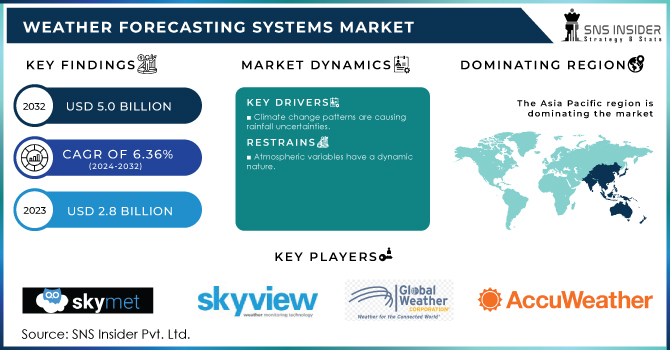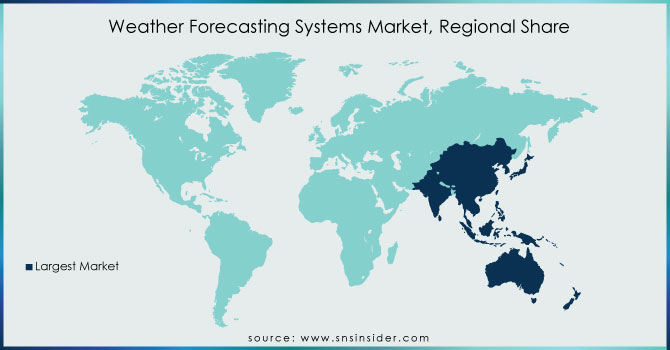Weather Forecasting Systems Market Report Scope & Overview:

To get more information on Weather Forecasting Systems Market - Request Free Sample Report
The Weather Forecasting Systems Market was valued at USD 2.8 billion in 2023 and is expected to grow to USD 5.0 billion by 2032, achieving a compound annual growth rate (CAGR) of 6.36% over the forecast period of 2024-2032.
Weather forecasting services encompass a wide range of meteoro logically related methods, tools, solutions, and approaches. The process of weather forecasting comprises the use of numerous techniques to analyse atmospheric data and offer current or future weather formats for a specific location. Weather forecasting makes extensive use of structured and unstructured data to boost analytical output while increasing revenue for a variety of end-use industries.
The market is growing due to expansion in the aviation and shipping industries, as well as an increase in safety concerns among end-use industries. Furthermore, increased generation of renewable energy fuels industry expansion. However, the difficulties connected with weather forecasting models and a shortage of experienced labour are projected to stymie market expansion.
Furthermore, technological advancements in computing systems and the expansion of the transportation industry in developing countries are expected to provide lucrative opportunities for the growth of the weather forecasting services market.
MARKET DYNAMICS
KEY DRIVERS
-
Continuous weather monitoring is required to enable disaster management.
-
Climate change patterns are causing rainfall uncertainties.
RESTRAINTS
-
Atmospheric variables have a dynamic nature.
-
Model complexity in weather forecasting
OPPORTUNITIES
-
Weather monitoring using high-end radar and tiny satellites
-
Increasing supercomputer computational capabilities for weather forecasting
CHALLENGES
-
The occurrence of misleading weather warnings
-
A substantial capital investment is required.
IMPACT OF COVID-19
The grounding of the worldwide aviation fleet has resulted in a sharp decrease in the movement of commercial aircraft, which is a main source of critical weather data. Meteorological agencies use this data to improve the accuracy of weather predictions, including the occurrence of catastrophic weather events such as hurricanes. For example, by the end of March 2020, the data produced by the US-based aircraft fleet had decreased by 50%, while the readings provided by aircraft across North America had decreased by 80%, according to the European Centre of Medium Range Weather Forecasts.
The centre calculated that if all data given by North America's aircraft fleet were suddenly unavailable, weather forecast accuracy would fall by an average of 15%. In the shipping business, a similar paradigm can be observed. Sea-based measurements are critical for forecasting weather over the oceans as well as maintaining long-term records of ocean health and climate changes. However, the number of shipboard observations has been continuously falling since March 2020, with a 15% loss of stations accounted for since the epidemic. The short-term outlook for the weather forecasting systems market is ultimately contingent on governments' swift response to the COVID-19 outbreak, the efficiency of their efforts, and the ongoing pandemic's influence on the global economy.
Weather satellites are expected to lead the weather forecasting systems market from 2023 to 2030, and this segment is expected to grow further due to the increasing need for earth monitoring and weather observing systems to measure, monitor, and provide valuable inputs on a variety of climatic parameters.
The aviation segment dominated the weather forecasting services market by end-use industry in 2021 and is likely to maintain its dominance in the future years, owing to increased connectivity of aerospace IT infrastructure in the aviation industry. However, the transportation category is predicted to grow at the fastest rate over the projection period, as transportation system security can directly influence operational safety and productivity in the industry, as well as indirectly impact services.
The market is divided into three segments based on forecast range: short-range forecast, medium-range forecast, and long-range forecast. The Medium-Range Forecast category is expected to grow the fastest over the anticipated time period. This time span is between 7 and 10 days. It is used in areas including as agriculture, water management, and flood control. Medium-Range weather information is useful when firms make minor operational plan decisions.
Weather forecasting systems are used in aviation, energy, agriculture, retail, media, and other industries. Weather forecasting services provide early warnings of changes in the weather, allowing businesses to arrange weather-sensitive activities at the proper time, assuring safety and sustainability. As these organisations' security and safety concerns grow, so does the demand for weather forecasting services in order to avoid ecological disasters and natural disasters while also increasing revenue streams. For example, the aviation industry relies on forecasting services to stay current on air traffic control and weather. Furthermore, weather forecasting services offer dependable communication services and products to meet the specific needs of government-centric maritime operations.
KEY MARKET SEGMENTATION
By Type
-
Short-range Forecasting
-
Medium-range Forecasting
-
Long-range Forecasting
By End-use
-
Transportation
-
Aviation
-
Energy & Utilities
-
BFSI
-
Agriculture
-
Media
-
Manufacturing
-
Retail
-
Others
By Application
-
Weather Satellites
-
Weather Observing Systems
-
Weather Stations
-
Weather Drones
-
Weather Balloons
-
Weather LiDAR
-
Weather Radar
-
Others
By Solution
-
Hardware
-
Software
REGIONAL ANALYSIS
From 2021 to 2028, Asia Pacific is predicted to lead the weather forecasting systems market. The Asia Pacific weather forecasting Systems market is expanding due to a greater emphasis on growing investments in weather forecasting Systems technologies by countries in this area. Furthermore, regional economies have undertaken a number of projects linked to sustainable and renewable energy generation in order to protect the environment and avoid future energy crises. Due to the vulnerability of most renewable energy sources to weather fluctuations, the necessity to maximise energy output mandates the adoption of sophisticated weather monitoring and forecasting systems to assure optimal output, hence boosting the weather forecasting systems market in the region.

Need any customization research on Weather Forecasting Systems Market - Enquiry Now
REGIONAL COVERAGE:
-
North America
-
USA
-
Canada
-
Mexico
-
-
Europe
-
Germany
-
UK
-
France
-
Italy
-
Spain
-
The Netherlands
-
Rest of Europe
-
-
Asia-Pacific
-
Japan
-
south Korea
-
China
-
India
-
Australia
-
Rest of Asia-Pacific
-
-
The Middle East & Africa
-
Israel
-
UAE
-
South Africa
-
Rest of Middle East & Africa
-
-
Latin America
-
Brazil
-
Argentina
-
Rest of Latin America
-
KEY PLAYERS
The Key Players are Skymet Weather Services Pvt., Ltd., Skyview Systems Ltd., Global Weather Corporation, Accuweather Inc., BMT Group, Fugro, Enav S.p.A, Met Office, Precision Weather, The Weather Company, and other players
| Report Attributes | Details |
|---|---|
| Market Size in 2022 | US$ 2.8 Billion |
| Market Size by 2030 | US$ 5.0 Billion |
| CAGR | CAGR of 6.36% From 2023 to 2030 |
| Base Year | 2022 |
| Forecast Period | 2023-2030 |
| Historical Data | 2020-2021 |
| Report Scope & Coverage | Market Size, Segments Analysis, Competitive Landscape, Regional Analysis, DROC & SWOT Analysis, Forecast Outlook |
| Key Segments | • By Type (Short-range Forecasting, Medium-range Forecasting, and Long-range Forecasting) • By End-use (Transportation, Aviation, Energy & Utilities, BFSI, Agriculture, Media, Manufacturing, Retail, and Others) • By Application(Weather Satellites, Weather Observing Systems, Weather Stations, Weather Drones, Weather Balloons, Weather LiDAR, Weather Radar, Others) • By Solution(Hardware, Software) |
| Regional Analysis/Coverage | North America (USA, Canada, Mexico), Europe (Germany, UK, France, Italy, Spain, Netherlands, Rest of Europe), Asia-Pacific (Japan, South Korea, China, India, Australia, Rest of Asia-Pacific), The Middle East & Africa (Israel, UAE, South Africa, Rest of Middle East & Africa), Latin America (Brazil, Argentina, Rest of Latin America) |
| Company Profiles | Skymet Weather Services Pvt., Ltd., Skyview Systems Ltd., Global Weather Corporation, Accuweather Inc., BMT Group, Fugro, Enav S.p.A, Met Office,Precision Weather, The Weather Company, and other players. |
| DRIVERS | • Continuous weather monitoring is required to enable disaster management. • Climate change patterns are causing rainfall uncertainties. |
| RESTRAINTS | • Atmospheric variables have a dynamic nature. • Model complexity in weather forecasting |

